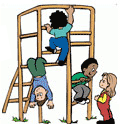Sponsored Links
Teaching ESL To Children
Teaching ESL to children is challenging but also very rewarding. Before I walk into a class of 10-year olds, I take a deep breath. Children have no attention span AT ALL, and so I tell myself to slow right down before I start. Teaching children requires patience and a sense of fun and playfulness. Even though it seems obvious, a common mistake is to think that children are simply 'short adults!' This is sure to get you off on the wrong foot!
Here are some tips for teaching ESL to children:
1. Involve Children in an hands-on Activities. Children's minds are incredibly open and they learn by absorbing ideas and concepts directly. Children need to be actively involved. Get students up and out of their chairs and moving around. Sing songs, and play games.
2. Avoid talking for long periods of time. I find that the energy level of the classroom drops lower and lower. Explain an activity quickly and then go to it. Keep the energy moving! If your planned activity is a flop, move on. Keep a few extra activities handy for this purpose. Children need lots of stimulation all the time.
3. Children learn by interacting with each other and with the teacher. Try to talk to each child individually each class. Whenever possible, have children working in groups and in pairs.
4. Review, Review, Review. New information is absorbed and has meaning when it is related to information students have already learned. Quickly review new concepts at the beginning of each class.
5. Encourage students to correct themselves and other students. Self correction or self-regulation is an important part of learning. Students should be encouraged to ask, "How am I doing?" and "Am I doing this right?" in an open and non-judgmental environment. Children raised in authoritative cultures may need additional re-inforcement.
6. Use what is learned in different contexts. The more contexts used the better, and the more concrete and 'real life' the contexts the better. Make it real for students by talking about them and their lives.
7. Praise, Praise, Praise. Encourage and build students up in a natural way. Learning occurs when students are motivated and feel good about themselves.
Looking back on my years of teaching, the children's classes took a bit of getting used to, but were the most memorable and fun!
About the Author:
By: George Stocker
George and Daisy Stocker have traveled the world teaching ESL to children and adults. Their website, http://www.efl-esl.com offers ESL curriculum, activities, an online forum for ESL teachers and students, plus a free ESL teachers newsletter! Their second website http://www.esl-storybooks.com offers curriculum and storybooks for children.
04.12.2006. 09:04
This article hasn't been commented yet.
 New Comments
New Comments
 Sponsored Links
Sponsored Links
 Other Languages - Learning Resources
Other Languages - Learning Resources
-
- Learn Chinese (Mandarin)
- Cantonese (Coming Soon)
If you have any games to add, or are would like to contact us for any other reason please use this form to do so.






 New Games
New Games
Write a comment